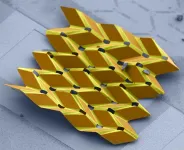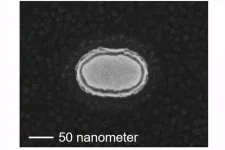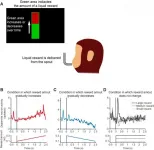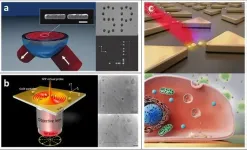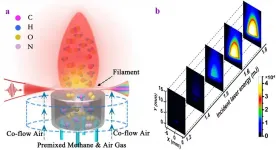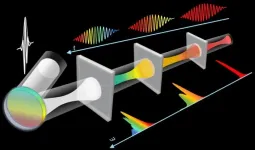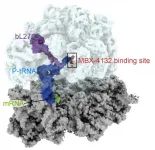Difficulty learning nonsense words may indicate a child's high risk of dyslexia
Studies show disorder is linked to the left cerebral hemisphere, and that confidence can help kids overcome difficulties
2021-03-19
(Press-News.org) Researchers at Aalto University and the Niilo Mäki Institute have used neuroimaging to pinpoint where the brain activates - or doesn't activate - among children identified as having a high risk of dyslexia. Magnetoencephalography (MEG) has rarely been used to study the reading disorder in children.
The brain study was carried out at Aalto University by measuring brain activity with MEG, which measures the weak magnetic fields arising from electrical activity in the brain, over a period of two days. Earlier studies have shown that difficulties in processing sounds may be partly responsible for dyslexia, and that these challenges may relate to the left auditory cortex which processes language.
During the study, the children listened to nonsensical four-syllable words from a loudspeaker and were asked to repeat them. The researchers then asked the children if they had heard the word before.
'The words were nonsense words that really don't mean anything. We wanted to see how the kids learned to create memories of new words. We noticed that children at a high risk of dyslexia also have deficiencies in learning new words based on hearing them. Their memories of new words were not very precise, and they weren't capable of differentiating the made-up words from each other. This is an indication of a broader difficulty in processing words in the brain, which makes learning to read more difficult as well', says Dr Anni Nora, a postdoctoral researcher who developed the MEG measurement test together with Professor Riitta Salmelin and Assistant Professor Hanna Renvall at Aalto University.
Neural activation in the right cerebral hemisphere of the children at a high risk of dyslexia was comparable to that of children in the control group. Problems in processing the sound content of speech, and in learning new words was focused in activity of the left-hemisphere auditory cortex -- the area of the brain that specialises in processing language and speech, and where word memory support is located.
'Considerably less brain activation was found in the left cerebral hemisphere among children at risk of dyslexia. Particularly in children, the processing of language and speech can also be seen in the right hemisphere, but over time the emphasis moves to the left side - each side focuses on more specific tasks as kids grow older. It would be interesting to know if problems with reading and writing are caused by how the cerebral hemispheres specialise,' Nora adds.
Study participants were in their first and second years of school and had been identified, with the help of a teacher, as high risk. The research team performed neuropsychological examinations, tested reading and writing skills and cognitive abilities, and measured brain functions. The children were also asked about their motivation, including their beliefs about their own reading skills.
Support from tips and feedback
Anomalous brain activity at age 7 or 8 did not completely predict later development of reading; other factors seem to be involved, including a child's belief in their own ability to learn. The Niilo Mäki Institute studied this further, using tools and tests including a game called GraphoLearn (in Finnish Ekapeli), which is used to teach reading skills to Finnish children.
'Children were asked to read out both words and meaningless pseudowords that they could not guess. The study also included a part that tested how GraphoLearn affected difficulties in reading and writing. Generally, playing this learning game did not have a significant effect. But children who were confident about their reading skills got additional benefit from playing the game, and they made better progress in their reading skills than those in the control group. It might be a good idea to develop tools for special education teachers to help them support children's self-efficacy', says postdoctoral researcher Miia Ronimus of the Niilo Mäki Institute.
GraphoLearn is a mobile learning game developed at the University of Jyväskylä and the Niilo Mäki Institute. The players connect letters to the sounds of speech and the game adapts to the child's skill level. Children with the weakest reading and writing skills were selected for the six-week GraphoLearn period. Supervision of the exercise was left to the teachers and parents. Based on the study, features such as tips and verbal feedback were added to the game.
'The learning game now offers tips on how to improve performance. If a child reacts very quickly, for example, the game might instruct the child to take it easy and slow down,' Ronimus says.
INFORMATION:
The research was conducted by a consortium funded by the Academy of Finland. The principal researchers were, in addition to Riitta Salmelin, Professors Heikki Lyytinen from the University of Jyväskylä and Juha Kere from Folkhälsan. The research project began in the autumn of 2015 and took a total of four years. 300 children took part in the reading study, and 35 of them took part in the brain study. Of the children taking part in the brain study, 23 had a high risk of developing dyslexia and 12 read at a normal level.
ELSE PRESS RELEASES FROM THIS DATE:
2021-03-19
At the start of Neurodiversity Celebration Week, new research from Cranfield University demonstrates the importance of organisations becoming more inclusive employers when it comes to neurodiversity.
It has been estimated that one in seven of the population of the UK is neurodiverse. However, according to research by the Institute of Leadership and Management, only half of managers would employ a neurodiverse person.
Last week, in an interview with The Times, The Second Sea Lord Vice Admiral Nick Hine, revealed that ten years ago he was diagnosed with autism.
Speaking to The Times, the Vice Admiral, said: ""The world is made for neuro-typical people by neuro-typical people, and therefore it's not surprising that people who are not neuro-typical have a ...
2021-03-19
RESEARCH TRIANGLE PARK, N.C. -- Army-funded researchers created nanosized robots that could enable locomotion, novel metamaterial design and high-fidelity sensors.
Cornell University researchers created micron-sized shape memory actuators that fold themselves into 3D configurations and allow atomically thin 2D materials with just a quick jolt of voltage. Once the material is bent, it holds its shape, even after the voltage is removed.
To demonstrate the technology, the team created what is potentially the world's smallest self-folding origami bird.
"The research team is pushing the boundary of how quickly and precisely we can control motion at the micro- and even nano-scales," said Dr. Dean Culver, program manager for Complex Dynamics and Systems at Army Research Office, ...
2021-03-19
Infection with severe acute respiratory syndrome coronavirus 2 (SARS-CoV-2) in pregnancy is associated with preeclampsia, stillbirth, preterm birth and other adverse outcomes, found new research published in CMAJ (Canadian Medical Association Journal) .
"Our findings suggest that pregnant people with COVID-19 have an increased risk of high blood pressure, stillbirth and preterm birth. Their newborns are more likely to need intensive care. Pregnant people with severe COVID-19 symptoms have a particularly high risk of these complications," says Dr. Nathalie ...
2021-03-19
An important function of the grant peer review process is to provide constructive feedback to applicants for their resubmissions. However, little is known about whether review feedback achieves this goal.
The American Institute of Biological Sciences (AIBS), in collaboration with Washington State University, has published findings on a multi-methods analysis of responses from grant applicants regarding their perceptions of the usefulness and appropriateness of peer review feedback they received from grant submissions.
The analysis focused on responses ...
2021-03-19
Tohoku University researchers have, for the first time, developed the technology for the nanosecond operation of the spintronics-based probabilistic bit (p-bit) - dubbed the poor man's quantum bit (q-bit).
The late physicist R.P. Feynman envisioned a probabilistic computer: a computer that is capable of dealing with probabilities at scale to enable efficient computing.
"Using spintronics, our latest technology made the first step in realizing Feynman's vision," said Shun Kanai, professor at the Research Institute of Electrical Communication at Tohoku University and lead author of the study.
Magnetic tunnel junctions (MTJs) are the key component of non-volatile ...
2021-03-19
Tsukuba, Japan - Animals must make predictions about future rewards when making decisions during daily life. Specific reward-related patterns of neuronal activity are known to underlie such decisions. But now, researchers from Japan have found a new pattern of neural activity that occurs when responding to rewards that are changing over time.
In a study published this month in eLife, researchers from the University of Tsukuba have revealed that dopamine neurons, which process information about rewards, are activated in a previously undetected way when an animal considers a reward that is changing in value.
Previous studies have highlighted ...
2021-03-19
Optical tweezers and associated manipulation tools in the far field have had a major impact on scientific and engineering research by offering precise manipulation of small objects. More recently, the near-field manipulation with surface plasmons has opened opportunities not feasible with conventional far-field optical methods. The use of surface plasmon techniques enables excitation of hotspots much smaller than the free-space wavelength; with this confinement, the plasmonic field facilitates trapping of various nanostructures and materials with higher precision. It has become commonly used in trapping of micro- and nanometre-sized objects in various fields of science.
In a new review paper published in Light Science & Application, a team of scientists, led by Professor ...
2021-03-19
Laser ignition (LI) is a promising electrode-less alternative to electronic spark ignition of lean fuel/air mixtures, offering high thermal efficiency with low harmful emissions. One of the most widely adopted LI methods is nanosecond laser-induced spark ignition (ns-LISI), in which combustible mixtures undergo multiphoton ionization followed by avalanche breakdown, resulting in high-temperature and high-pressure plasma along with shockwaves. However, inevitable shot-to-shot energy fluctuations resulting from ns light sources lead to the stochastic nature of the breakdown, influencing reaction routes and producing potential misfiring.
Although LI is not a new concept, it is commonly deemed that igniting lean-fuel mixtures by an ultrashort femtosecond (fs) ...
2021-03-19
Generating intense ultrashort pulses with high spatial quality has opened up possibilities for ultrafast and strong-field science. It is so important that the Nobel Prize in Physics 2018 was given to Dr. Strickland and Dr. Mourou for inventing a technique called chirped pulse amplification, which drives numerous ultrafast lasers worldwide. With the great advancement in the last decade, Yb-based ultrafast lasers have become highly popular, because they exhibit exceptional thermal efficiency, are low in cost and are highly flexible in adjusting pulse energies and repetition rates. However, the pulse durations from these lasers are usually not shorter than 100 fs or even 1 ps, which requires external ...
2021-03-19
UNIVERSITY PARK, Pa. -- A new antibiotic compound clears infection of multi-drug resistant gonorrhea in mice in a single oral dose, according to a new study led by researchers at Penn State and Emory University. The compound targets a molecular pathway found in bacteria but not humans and could lead to new treatments for gonorrhea and infections from other bacteria, such as tuberculosis and MRSA.
The research team, which also includes scientists from the biopharmaceutical company Microbiotix, the Uniformed Services University, and Florida State, published their results in a paper appearing March 19 ...
LAST 30 PRESS RELEASES:
[Press-News.org] Difficulty learning nonsense words may indicate a child's high risk of dyslexia
Studies show disorder is linked to the left cerebral hemisphere, and that confidence can help kids overcome difficulties
